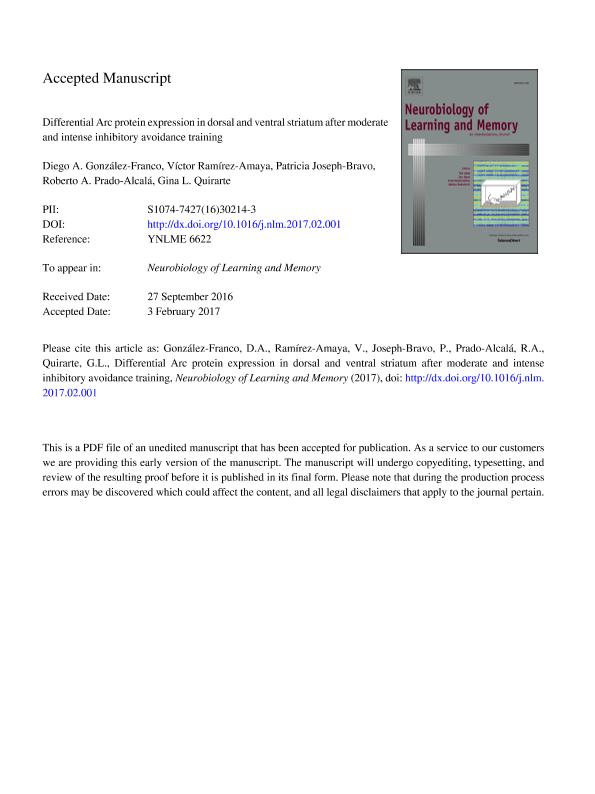Mostrar el registro sencillo del ítem
dc.contributor.author
González Franco, Diego A.
dc.contributor.author
Ramirez Amaya, Victor

dc.contributor.author
Joseph Bravo, Patricia
dc.contributor.author
Prado Alcalá, Roberto A.
dc.contributor.author
Quirarte, Gina L.
dc.date.available
2018-11-08T18:20:15Z
dc.date.issued
2017-04-06
dc.identifier.citation
González Franco, Diego A.; Ramirez Amaya, Victor; Joseph Bravo, Patricia; Prado Alcalá, Roberto A.; Quirarte, Gina L.; Differential Arc protein expression in dorsal and ventral striatum after moderate and intense inhibitory avoidance training; Academic Press Inc Elsevier Science; Neurobiology of Learning and Memory; 140; 6-4-2017; 17-26
dc.identifier.issn
1074-7427
dc.identifier.uri
http://hdl.handle.net/11336/63999
dc.description.abstract
Intense training refers to training mediated by emotionally arousing experiences, such as aversive conditioning motivated by relatively high intensities of foot-shock, which produces a strong memory that is highly resistant to extinction. Intense training protects memory consolidation against the amnestic effects of a wide variety of treatments, administered systemically or directly into brain structures. The mechanisms of this protective effect are unknown. To determine a potential neurobiological correlate of the protective effect of intense training, rats were trained in a one-trial step-through inhibitory avoidance task using different intensities of foot-shock (0.0, 0.5, 1.0, and 2.0 mA). Some rats from each group were sacrificed 45 min after training for immunohistochemical Arc protein detection in dorsal and ventral striatum; other rats were tested for extinction during six consecutive days, starting 48 h after training. The results showed that training with 1.0 and 2.0 mA produced optimal retention scores, which were significantly higher than those of the 0.5 and 0.0 mA groups. Also, a higher resistance to extinction was obtained with 2.0 mA than with the other intensities. A high number of neurons expressed Arc in ventral, but not in dorsal striatum in both the 1.0 and 2.0 mA groups, with a larger area of Arc signal in the latter group. We conclude that an increased Arc expression may be related to enhanced synaptic plasticity in the ventral striatum, suggesting that it may be one of the physiological substrates of enhanced learning.
dc.format
application/pdf
dc.language.iso
eng
dc.publisher
Academic Press Inc Elsevier Science

dc.rights
info:eu-repo/semantics/openAccess
dc.rights.uri
https://creativecommons.org/licenses/by-nc-sa/2.5/ar/
dc.subject
Corticosterone
dc.subject
Immediate-Early Genes
dc.subject
Learning And Memory
dc.subject
Over-Training
dc.subject
Striatum
dc.subject.classification
Otras Ciencias Biológicas

dc.subject.classification
Ciencias Biológicas

dc.subject.classification
CIENCIAS NATURALES Y EXACTAS

dc.title
Differential Arc protein expression in dorsal and ventral striatum after moderate and intense inhibitory avoidance training
dc.type
info:eu-repo/semantics/article
dc.type
info:ar-repo/semantics/artículo
dc.type
info:eu-repo/semantics/publishedVersion
dc.date.updated
2018-10-22T15:50:39Z
dc.identifier.eissn
1095-9564
dc.journal.volume
140
dc.journal.pagination
17-26
dc.journal.pais
Estados Unidos

dc.journal.ciudad
San Diego
dc.description.fil
Fil: González Franco, Diego A.. Universidad Nacional Autónoma de México; México
dc.description.fil
Fil: Ramirez Amaya, Victor. Consejo Nacional de Investigaciones Científicas y Técnicas; Argentina. Universidad Autónoma de Querétaro; México
dc.description.fil
Fil: Joseph Bravo, Patricia. Universidad Nacional Autónoma de México; México
dc.description.fil
Fil: Prado Alcalá, Roberto A.. Universidad Nacional Autónoma de México; México
dc.description.fil
Fil: Quirarte, Gina L.. Universidad Nacional Autónoma de México; México
dc.journal.title
Neurobiology of Learning and Memory

dc.relation.alternativeid
info:eu-repo/semantics/altIdentifier/url/http://www.sciencedirect.com/science/article/pii/S1074742716302143
dc.relation.alternativeid
info:eu-repo/semantics/altIdentifier/doi/https://dx.doi.org/10.1016/j.nlm.2017.02.001
Archivos asociados
